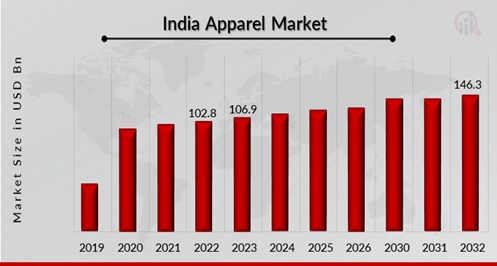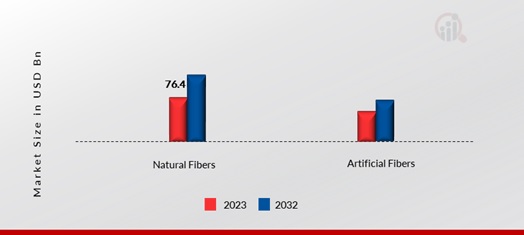India Apparel Market Overview
India Apparel Market Size was valued at USD 102.8 Billion in 2022. The India Apparel market industry is projected to grow from USD 106.9 Billion in 2023 to USD 146.3 Billion by 2032, exhibiting a compound annual growth rate (CAGR) of 4.0% during the forecast period (2024 - 2032). An influential market driver propelling the apparel market in India is the expanding middle-class demographic's evolving lifestyle preferences and rising disposable income.

Source: Secondary Research, Primary Research, MRFR Database and Analyst Review
India Apparel Market Trends
- Widespread use of e-commerce platforms is driving the market growth
Consumer behavior in the Indian apparel market has undergone a substantial transformation since the advent and exponential expansion of e-commerce platforms. Multiple factors, including rising internet penetration, smartphone usage, convenience, and the availability of a vast array of products, have contributed to this trend. Because of its accessibility and convenience, e-commerce has emerged as a favored purchasing option for numerous consumers. The proliferation of digital technologies and the widespread use of smartphones have provided consumers with convenient access to an extensive assortment of clothing choices. This factor of expediency has contributed substantially to the expansion of online apparel sales in India. Additionally, e-commerce platforms provide an extensive selection of products from both domestic and international brands, enabling customers to investigate and contrast various items effortlessly. The combination of a wide array of products, intuitive interfaces, and streamlined payment processes has garnered a significant number of customers to the apparel industry's online marketplace. An additional noteworthy development influencing the Indian apparel industry is the increasing desire for environmentally sustainable fashion and ethical consumer behavior. As public consciousness regarding environmental issues and social responsibility grows, consumers are exhibiting a heightened awareness regarding the ethical and environmental consequences that may result from their purchasing choices.
Sustainable fashion comprises a multitude of practices that are designed to mitigate the ecological impact of the apparel sector. These practices comprise the utilization of environmentally favorable materials, ethical manufacturing procedures, and waste reduction across the entire supply chain. Changing consumer preferences, government initiatives promoting sustainability, and the efforts of industry stakeholders to implement more environmentally friendly practices have all contributed to the recent surge in sustainable fashion in India. Consumer preoccupation with the ecological and societal ramifications of rapid fashion is a significant factor propelling the development of sustainable fashion in India. Fast fashion, distinguished by its expeditious manufacturing processes and inexpensive, non-recyclable garments, has been linked to ecological deterioration, labor exploitation, and unethical conduct throughout its supply chain.
India Apparel Market Segment Insights
- Apparel Raw Material Insights
The India Apparel market segmentation, based on the raw material, includes natural fibers and artificial fibers. The natural fibers category, which encompasses cotton, silk, wool, and jute, generally holds the most significant market share within the apparel industry in India. Particularly dominant is cotton on account of its extensive accessibility, adaptability, and cost-effectiveness. Cotton production and export by India is among the most substantial on a global scale, substantially bolstering the country's market dominance. Moreover, consumers frequently favor natural fibers due to their convenience, breathability, and perceived environmental advantages, which contribute to their increased market share in the nation's apparel sector.
Figure 1: India Apparel Market by Raw Material, 2023 & 2032 (USD Billion)

Source: Secondary Research, Primary Research, MRFR Database and Analyst Review
Apparel Product Type Insights
The India Apparel market segmentation, based on product type, includes Yarn, Fabric, Fibre, and Others. Among the segments above, fabric generally holds the most substantial market share in the Indian textile industry. Fabric denotes the processed substance that is employed in the production of technical textiles, apparel, and an assortment of other goods. This segment comprises a wide variety of materials, such as cotton, silk, polyester, and blends, to accommodate the varied requirements and preferences of consumers. Fabric production is a critical component of the textile value chain, as it provides the principal basic material utilized in the manufacture of garments and various subsequent industries. Consequently, fabric dominates the market as a result of its indispensable function in a multitude of end-use applications spanning diverse industries.
Apparel Country Insights
Numerous factors are contributing to the substantial expansion of the textile and apparel industry in India, including increasing disposable income, shifting consumer preferences, technological advancements, and favorable government policies. India's textile industry—one of the largest exporters and producers of textiles and garments in the world—makes a substantial economic and employment-generating contribution to the nation. An important catalyst for market expansion is the rising disposable income of India's populace, specifically the expanding middle class. Consumers are more inclined to spend their increased purchasing power on apparel and textiles for personal use and interior design as a result of rising income levels; this stimulates market demand. Furthermore, evolutions in consumer inclinations and lifestyle patterns have resulted in a transition towards branded and stylish clothing, thereby stimulating expansion within the structured retail industry. In response to this escalating demand, both domestic and international fashion brands are augmenting their market share in India, thereby fostering market expansion.
India Apparel Key Market Players & Competitive Insights
The market development in the Indian textile and apparel market is comprised of both domestic and international firms functioning in diverse industry segments. Prominent domestic textile corporations, including Aditya Birla Group, Reliance Industries, and Arvind Limited, maintain a substantial market share by capitalizing on their vast manufacturing capacities, well-established brands, and extensive distribution systems. These major players in the India Apparel market exercise market dominance in various sectors, including apparel, fabric, and yarn, by providing an extensive assortment of products that appeal to both domestic and international clientele. Furthermore, the presence of numerous small-scale manufacturers and regional participants enhances the level of competition, specifically in niche markets and regional areas, thereby augmenting the market's vitality and variety.
Fashion brands and merchants from around the world have been progressively increasing their presence in India, leveraging the nation's expanding consumer population and advantageous market circumstances. Leading market players include Welspun Group, Vardhman Group, Alok Industries Limited, Raymond Limited, Bombay Dyeing, and Garden Silk Mills Limited.
Key Companies in the India Apparel market include
- Welspun Group
- Vardhman Group
- Alok Industries Limited
- Raymond Limited
- Bombay Dyeing
- Garden Silk Mills Limited
India Apparel Market Segmentation
India Apparel Raw Material Outlook
- Natural Fibers
- Artificial Fibers
India Apparel Product Type Outlook
| Report Attribute/Metric |
Details |
| Market Size 2022 |
USD 102.8 Billion |
| Market Size 2023 |
USD 106.9 Billion |
| Market Size 2032 |
USD 146.3 Billion |
| Compound Annual Growth Rate (CAGR) |
4.0% (2024-2032) |
| Base Year |
2023 |
| Market Forecast Period |
2024-2032 |
| Historical Data |
2019- 2022 |
| Market Forecast Units |
Value (USD Billion) |
| Report Coverage |
Revenue Forecast, Market Competitive Landscape, Growth Factors, and Trends |
| Segments Covered |
Raw Material, Product Type, and Region |
| Countries Covered |
India |
| Key Companies Profiled |
Welspun Group, Vardhman Group, Alok Industries Limited, Raymond Limited, Bombay Dyeing, and Garden Silk Mills Limited |
| Key Market Opportunities |
· Tap into the growing affluent consumer base by offering high-end fashion and luxury textiles. · Capitalize on untapped rural demand through affordable and durable clothing options tailored to local preferences. |
| Key Market Dynamics |
· Rising purchasing power drives demand for clothing and textiles. · Supportive initiatives and incentives promote industry growth, investment, and innovation. |
Frequently Asked Questions (FAQ) :
The India Apparel market size was valued at USD 106.9 Billion in 2023.
The market is projected to grow at a CAGR of 4.0% during the forecast period, 2024-2032.
The key players in the market are Welspun Group, Vardhman Group, Alok Industries Limited, Raymond Limited, Bombay Dyeing, and Garden Silk Mills Limited.
The natural fibers category dominated the market in 2023.
The fabric category had the largest share of the market.




























